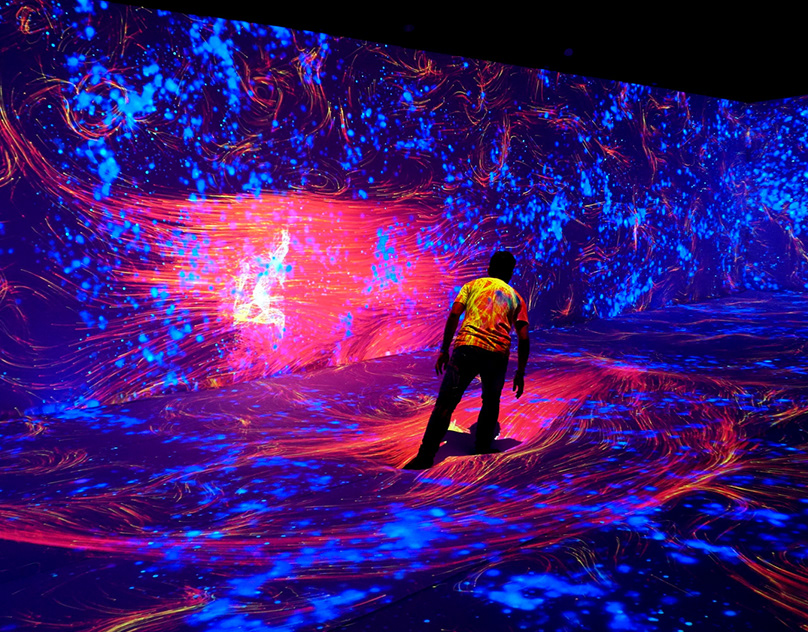Introduction
The world of art is evolving rapidly, and today’s audiences are no longer content to simply observe from a distance. Instead, they crave interaction, emotion, and total engagement. This is where immersive art experiences come in—blending physical environments with multimedia, storytelling, and often, cutting-edge technology. These experiences break down barriers between the artwork and the viewer, creating powerful moments that stay with people long after they leave the space. In this article, we’ll explore what immersive art means, how it’s changing the art landscape, and why it’s becoming a dominant trend in the creative world.
What Are Immersive Art Experiences?
To begin with, immersive art experiences are multi-sensory installations that envelop the viewer and make them feel part of the artwork. These experiences often incorporate sound, light, video projections, scent, texture, and spatial design to engage all the senses. The goal is to transport visitors into a different world—whether that’s an abstract concept, a historical event, or a futuristic vision.
Unlike traditional galleries where artworks hang on walls, immersive installations invite audiences to move through rooms, interact with elements, and sometimes even influence how the art reacts in real time.
The Rise of Immersive Art in Popular Culture
Over the past decade, immersive art experiences have gained massive traction in popular culture. Fueled by social media and a growing appetite for unique, shareable moments, people are lining up for the chance to step inside artistic environments that engage them on every level.
Moreover, brands and entertainment companies have taken notice. From fashion shows to product launches, immersive art has become a powerful tool for creating memorable, branded experiences. As a result, art has expanded beyond galleries and museums into shopping malls, abandoned warehouses, and even digital spaces.
Examples of Noteworthy Immersive Art Experiences
Some of the most talked-about projects worldwide highlight the creativity and emotional power of this art form. For example:
- Van Gogh: The Immersive Experience – A global exhibition that brings the iconic painter’s work to life using 360° projections, music, and narration.
- Meow Wolf (USA) – A surreal, multi-room environment created by artists, blending fantasy, science fiction, and interactive storytelling.
- teamLab Planets (Tokyo) – Visitors walk through water and floating flowers in digital dreamscapes that respond to movement.
Collectively, these experiences demonstrate how immersive art can captivate, inspire, and offer a deeper connection to artistic vision.

The Role of Technology in Creating Immersive Worlds
Furthermore, technology plays a crucial role in shaping today’s immersive art experiences. Tools such as virtual reality (VR), augmented reality (AR), motion sensors, and artificial intelligence allow artists to build responsive, dynamic environments that change with the viewer’s actions.
For instance, interactive projections can shift based on where a person moves, while spatial sound systems create audio that feels like it’s coming from different directions. These tools enhance the emotional impact and make the experience feel alive and personal.
In addition, new software and creative platforms are making it easier for independent artists to explore immersive formats without large budgets.
Why Immersive Art Experiences Matter
So why do these experiences resonate so deeply with people? Art has always been a powerful medium for communication, but making it immersive takes that power to a whole new level. These experiences encourage people to slow down, explore, and reflect. They can stir emotions, provoke thought, and create shared moments that are difficult to replicate in other forms of media.
In an era dominated by screens and digital overload, stepping into a carefully crafted environment that demands your full attention is both refreshing and therapeutic. In many cases, these experiences are more than just entertainment—they serve as a pathway to deeper human connection and creativity.
Art Beyond the Frame
Additionally, immersive art breaks the traditional mold. There’s no pedestal, no gallery rope, and no sign asking you not to touch. Instead, it’s about freedom—freedom to walk into a concept, feel its depth, and be part of its unfolding. This shift opens the door to more inclusive storytelling, where culture, identity, and innovation blend seamlessly to invite everyone into the art-making process.
The Future of Immersive Art Experiences
Looking ahead, the possibilities for immersive art experiences are virtually limitless. As technology continues to evolve, we can expect:
- AI-driven installations that learn and adapt based on audience behavior.
- Haptic feedback systems that allow users to feel textures or temperature changes.
- Virtual metaverse galleries offering immersive exploration from anywhere in the world.
Not only will these advancements elevate artistic creativity, but they will also make immersive experiences more accessible to people around the globe.
Conclusion
In conclusion, immersive art experiences are transforming how we think about and engage with creativity. They challenge boundaries, blur the lines between artist and audience, and offer unforgettable journeys through sound, light, and space. Whether you’re a lifelong art lover or just beginning to explore the creative world, stepping into one of these experiences can leave a lasting impression—and perhaps even change the way you see art forever.
To explore more artistic innovations and visual culture insights, visit us at https://sourcemaui.com/
